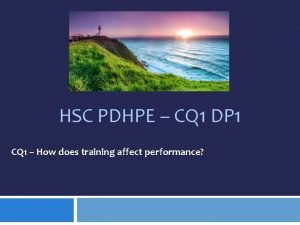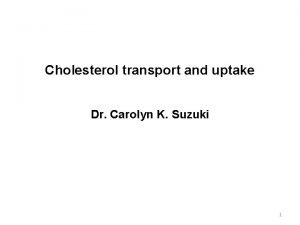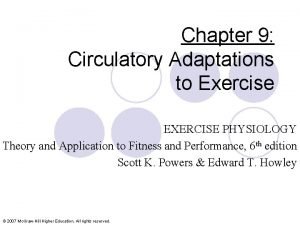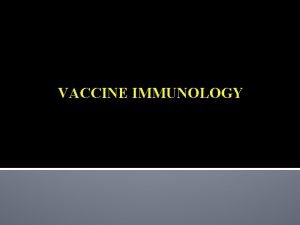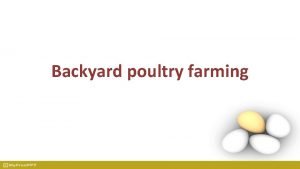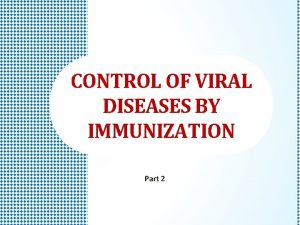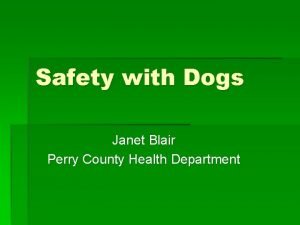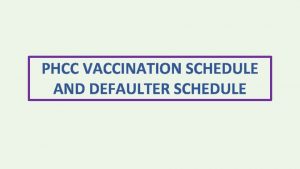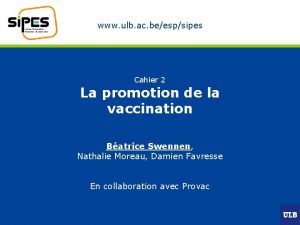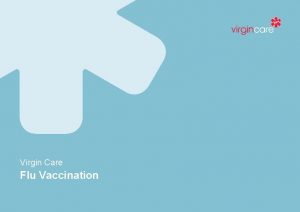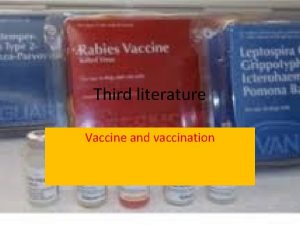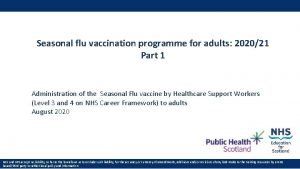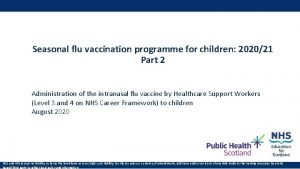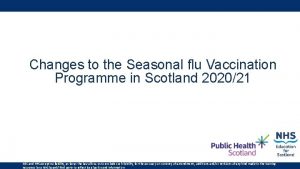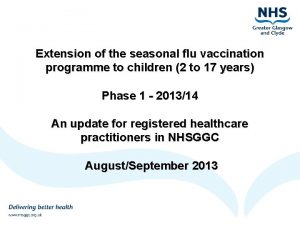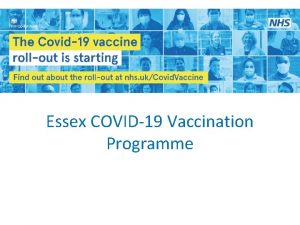Seasonal Flu Vaccination Programme Vaccine effectiveness and uptake









- Slides: 9

Seasonal Flu Vaccination Programme Vaccine effectiveness and uptake 2019/20 NES and HPS accept no liability, as far as the law allows us to exclude such liability, for the accuracy or currency of amendments, additions and/or revisions of any kind made to the training resources by a NHS board/third party to reflect local policy and information

Seasonal Flu Vaccination Programme Key messages • • • flu immunisation is one of the most effective interventions we can provide to reduce harm from flu and pressures on health and social care services during the winter by preventing flu infection through vaccination, secondary bacterial infections such as pneumonia are prevented. This reduces the need for antibiotics and helps prevent antibiotic resistance it is important to increase flu vaccine uptake in clinical risk groups because of increased risk of death and serious illness if people in these groups catch flu for a number of years, only around half of patients aged six months to under 65 years in clinical risk groups have been vaccinated influenza during pregnancy may be associated with perinatal mortality, prematurity, smaller neonatal size, lower birth weight and increased risk of complications for mother vaccination of health and social care workers protects them and reduces risk of spreading flu to their patients, service users, colleagues and family members NES and HPS accept no liability, as far as the law allows us to exclude such liability, for the accuracy or currency of amendments, additions and/or revisions of any kind made to the training resources by a NHS board/third party to reflect local policy and information

Flu Epidemiology in Scotland NES and HPS accept no liability, as far as the law allows us to exclude such liability, for the accuracy or currency of amendments, additions and/or revisions of any kind made to the training resources by a NHS board/third party to reflect local policy and information

Flu vaccine effectiveness • • Throughout the last decade, there has generally been a good match between the strains of flu in the vaccine and those that subsequently circulated Efficacy varies from one season to the next depending on circulating strains and how well they match Generally, lower efficacy is seen in the elderly although immunisation has been shown to reduce incidence of severe disease including bronchopneumonia, hospital admissions and mortality It is hoped that the use of adjuvanted and the new egg and cell based influenza vaccines will improve protection in the elderly and those most at risk of flu NES and HPS accept no liability, as far as the law allows us to exclude such liability, for the accuracy or currency of amendments, additions and/or revisions of any kind made to the training resources by a NHS board/third party to reflect local policy and information

Vaccine effectiveness – 2019/20 • • • Overall significant influenza VE seen in 2019/20 particularly against influenza A(H 1 N 1)pdm 09 As seen in the last two seasons there was reduced VE against A(H 3 N 2) The new QIVc vaccine provided significant protection for those in the 18 to 64 year of age VE was moderate in children aged 2 -17 years These findings support the on-going roll-out of the paediatric vaccine programme, but also highlight the importance of effective interventions to protect the adult age-groups. More details can be found in the PHE Annual Flu Report NES and HPS accept no liability, as far as the law allows us to exclude such liability, for the accuracy or currency of amendments, additions and/or revisions of any kind made to the training resources by a NHS board/third party to reflect local policy and information

Seasonal flu vaccine uptake in Scotland 2015 -16 2016 -17 2017 -18 2018 -19 2019 -20 65 years and older 74. 5% 72. 8% 73. 7% 74. 0% Under 65 yrs- At risk (excluding healthy pregnant women and carers) 48. 0% 44. 9% 44. 8% 42. 4% 42. 3% Pregnant women-no risk 49. 9% 49. 3% 48. 1% 44. 5% 42. 9% Aged 2 -5 yrs(not yet in school) 57. 1% 59. 0% 56. 9% 55. 8% 52. 5% Primary School 71. 5% 73. 0% 72. 9% 71. 1% Healthcare workers 33. 2% 35. 3% 45. 7% 51. 2% 53. 8% NES and HPS accept no liability, as far as the law allows us to exclude such liability, for the accuracy or currency of amendments, additions and/or revisions of any kind made to the training resources by a NHS board/third party to reflect local policy and information

When to vaccinate • those eligible should be given flu vaccination as soon as vaccine is available so that people are protected when flu begins to circulate in the community • ideally most vaccination should be completed before the end of December before flu circulation usually peaks • flu can circulate considerably later than this however so clinical judgement should be applied to assess needs of individual patients and whether it is appropriate to continue to offer vaccination from January to March • this decision should take into account level of flu-like illness in community and fact that the immune response following flu vaccination takes about two weeks to develop fully • protection afforded by the vaccine thought to last at least one influenza season • however, as antibody levels likely to reduce in subsequent seasons and there may be changes to circulating strains from one season to next, annual revaccination is important NES and HPS accept no liability, as far as the law allows us to exclude such liability, for the accuracy or currency of amendments, additions and/or revisions of any kind made to the training resources by a NHS board/third party to reflect local policy and information

Resources • • • NHS Inform NHS Education for Scotland Public Health Scotland Green Book Chapter 19 Guidance on Vaccine Storage and Handling • CMO Letter • Patient Group Directions NES and HPS accept no liability, as far as the law allows us to exclude such liability, for the accuracy or currency of amendments, additions and/or revisions of any kind made to the training resources by a NHS board/third party to reflect local policy and information

